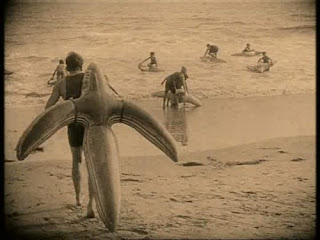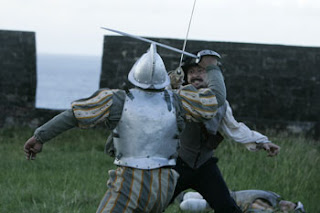Happy 4/20! I don't do drugs (though I'm still far from being a winner), but plenty of filmmakers either have, or have been inspired by drug-usage to create some perplexing visions. I take a look at four cult films that vary, whether their portrayal of drugs is the cause of, or solution to life's bigger problems.
Reefer Madness, a.k.a. Tell Your Children (USA, 1936)
Director: Louis J. Gasnier
The original anti-drug "educational" film gained a huge cult following in the following decades. Potheads from all over the world, and of all times gathering around to giggle at the stern image this film gives about their culture. There has also been a colorized version of the film which has the added interest in having different-colored pot smoke to come out of different characters, all relying on their mood.
At a local high school, Dr. Carroll (Joseph Forte) narrates a tale to a PTA meeting of how easily the youth can be corrupted. Drug pushers Mae (Thelma White) and Jack (Carleton Young) lure high school students to drop by at Mae's to smoke some "reefer cigarettes". This drug-smoking has various horrifying effects on the teens. One leaves the apartment intoxicated with his car and runs over a pedestrian. A girl is almost raped at a wild drug party. Sex-crazed potheads battle over girls, which causes a gun to go off. Won't somebody please think of the children!
The film is definitely a C-grade product of its time, with which I mean it moves along with a glacier's speed, the acting is hammy and the entire ordeal repetitive and quite boring. The funniest parts involve the straight-out finger pointing, hammering home the message to speak to the kids about the dangers of drugs. Which, of course have been wildly exaggerated and their portrayal hardly based on any empirical evidence. Yet still, you'd probably have to be stoned to enjoy this properly.
★★
Mystery of the Leaping Fish (USA, 1916)
Directors: Christy Cabane, John Emerson
Of course, American attitude over drugs hasn't always been as stern. In the early 20th century you could buy even hard drugs at a pharmacist's. A hilarious relic of this time is this short film, starring Douglas Fairbanks himself. Also appearing is Lupe Velez, best remembered from wanting to have a suicide that would give the press a field time and then dying with her head on the toilet. This comedy features the coke-fiend private detective Coke Ennyday (really!), who actually gets plenty of help to solving a case from chasing the horse. Regular cocaine ingestion also helps his crippling depression.
 |
| The Leaping Fish of the title refers to a sort of surfboard / blow-up toy. |
There are several quite perplexing visions throughout the film. Ennyday is a sort of an inventor, having several odd inventions in his home, such as a clock on his wall, that tells him when it's time to shoot dope. Money launderers iron out a whole mountain dollar bills. Ennyday's car has the same chess-pattern as his costume. Surfers lie on silly-looking blow-up fish dolls. The movie does run out of steam after a while, which makes it good it's only 25 minutes long. The end twist is a bit dumb, but it gives Fairbanks a chance to really parody his image as a clean-cut hero.
 |
| As if taking this role wasn't enough by itself. |
★★★ 1/2
Side note: These two older movies are public domain by now, so they can be legally watched all over the internet by now.
Liquid Sky (USA, 1982)
Director: Slava Tsukerman
Aesthetically beautiful, but somewhat incomprehensible plot-wise, this psychedelic epic has truly earned its cult-movie status. Pity it seems director Tsukerman had to return to his home planet in the vastness of space soon after this was finished. This product is truly one of a kind. The film has clearly inspired Gaspar Noe on his work.
 |
| Frames tell a lot more about this film than words ever could. |
Checking out what it's supposed to be about, microscopic aliens arrive on Earth on a flying dinner plate to seek for the chemical construction that makes heroin. Spying out the hedonistic life of a New York penthouse, the aliens realize that sexual pheromones are a lot more potent drug. A German scientist and an androgynous model follow the aliens and their ordeals nearby.
But all that nonsense is irrelevant. This is a steamy, sweaty film for a hot summer night. It's a vibrant, vivid, colorful piece of art that awakens emotions on a larger scale. It's a twisted, dark and sometimes nightmarish movie. The film's synthesizer soundtrack is perhaps even more iconic than the movie itself. The whole ordeal taps into New York City subculture of the times, when punk aesthetics were swept away in the wake of New Wave, and the hedonism and self-centerdness of the 80s was truly setting in. And before the discovery of AIDS, when coke-fiends were banging each other without a care in the world.
Now, since I watched it drunk, the film might have taken place in my fever dreams at least a bit. that's why I hesitate to give it the full ★★★★★ score. But when I get a chance to see it again, it may rise to new heights.
★★★★
Blue Sunshine (USA, 1978)
Director: Jeff Lieberman
For an even more sinister look at the drug-usage, this sci-fi thriller is fearful of the loss of control connected to drug usage. So much so that it warns the threat to be so vast as to be able to cross even a long period of time. Even worse than acid flashbacks, the users of the form of LSD known as Blue Sunshine, lose their minds years after having taken the drug. They lose their hair and grow an urge to murder. And murder just anyone in their vicinity, family member, random stranger or authority figure. Jerry Zipkin (Zalman King) is falsely accused of a mass murder at a party. On the run, he must gather evidence of the secret behind Blue Sunshine to clear his name and save the life of a presidential candidate.
 |
| A plot ripped straight from the headlines! |
It's another drug film that's definitely a product of its time. The paranoia and cynicism of the 70s saw that the carefree 60s had caused a lot of dangers to the modern world. These threats would blossom when erstwhile hippies have grown adult and risen to the position where they rule the world. Seedy discos, corrupt politicians and untrustworthy former friends occupy the modern world.
 |
| And nobody still thinks of the children! |
★★★ 1/2
Now, if you'll excuse me, I think I hear a bell toll.





































